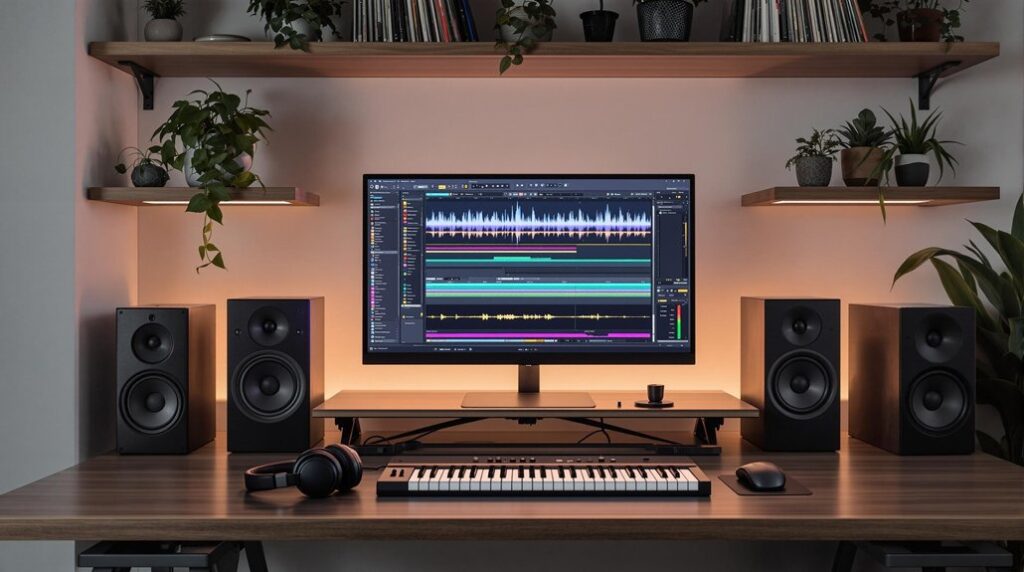In Ableton, you have several dither options to improve your audio quality during bit depth conversion. Triangular dither is ideal for maintaining fidelity and transparency in your mixes. Alternatively, you can choose from three POW-r modes that shape noise according to your mix’s dynamic range, with Type 3 being particularly effective for maintaining detail. Additionally, you can use rectangular dither, which minimizes noise but risks introducing quantization errors. Selecting the right dither type is essential for achieving peak audio integrity. Discovering the nuances of each option can further enhance your audio production process.
Key Takeaways
- Ableton Live provides various dither options including triangular, rectangular, and POW-r modes.
- Triangular dither enhances fidelity and transparency during audio processing.
- Rectangular dither reduces noise but may introduce quantization errors.
- POW-r dither comes in three types, with Type 3 being effective for dynamic range.
- Dithering should be applied only once during export for optimal audio quality.
Understanding Dithering
When you’re working with digital audio, understanding dithering is essential to maintaining sound quality during bit depth reduction. Dithering minimizes quantization distortion by adding controlled noise to audio signals, especially when converting from higher resolutions, like 24-bit, to lower, such as 16-bit.
In Ableton Live, you have several dither options, including Triangular and POW-r modes. Triangular dither, the default, balances noise distribution while preserving audio clarity, making it suitable for most mastering situations.
POW-r dithers (types 1, 2, and 3) implement psychoacoustic noise shaping, refining for specific audio dynamics.
Importance of Dithering
Understanding the role of dithering in digital audio production highlights its importance in maintaining sound quality. Dithering minimizes quantization errors by adding controlled noise, effectively masking rounding errors during bit depth conversions.
When you reduce bit depth, such as from 24-bit to 16-bit, dithering preserves audio fidelity and detail, preventing audible artifacts that could detract from the final mix. Properly applied dithering enhances the natural tonal balance of your recordings, ensuring intricate audio elements are maintained while improving overall dynamic range.
The choice of dithering settings, like Triangular or POW-r, can greatly impact audio quality, tailored to various audio types and dynamics. Neglecting this step during the mastering stage can lead to distortion and compromise audio integrity. Therefore, understanding advanced audio processing tools is crucial for achieving optimal results in your mastering workflow.
Dither Options in Ableton
Ableton Live offers a range of dither options that cater to different audio processing needs, allowing you to enhance sound quality during bit depth reduction.
The default Triangular dither enhances audio fidelity and transparency, making it safe for further processing. Alternatively, Rectangular dither reduces noise but may introduce quantization errors, which can be advantageous for specific audio types.
For best results, consider POW-r dither, available in three variations: Type 1, Type 2, and Type 3. Type 3 is particularly effective for dynamic recordings due to its aggressive noise shaping.
Applying Dithering in Ableton
To apply dithering in Ableton, you’ll need to navigate to the Export Audio/Video Dialog, which you can access via the File menu or by using the designated shortcut.
Before exporting, verify your mix is finalized and check your project settings. Choose appropriate export settings, including file format and sample rate. Select the desired bit depth, ideally reducing it to 16-bit or lower, to enhance audio quality.
- Experience the thrill of professional sound.
- Transform your audio with precision.
- Avoid the pitfalls of quantization noise.
When applying dithering, consider the dither options available, like Triangular dither, and remember to apply it only once during the export process for best results in your final output.
Post-Export Considerations
Once you’ve exported your audio, testing the file on various playback systems is essential for guaranteeing consistent sound quality across different environments.
When exporting audio, consider your dithering options carefully to maintain audio fidelity, especially if you’re working with high-resolution audio files. Select lossless formats like WAV or FLAC to guarantee compatibility with streaming services.
Additionally, assess the bit depth and file size; higher settings yield larger files, potentially complicating storage and transfer. It’s also important to ensure that you maintain proper headroom to prevent clipping during the mastering process.
Post-export considerations also include determining whether further processing is necessary. Collaborating with a mastering engineer can refine your project for a polished final product.
Always save your project files with original settings to facilitate future adjustments in your audio production workflow.
Frequently Asked Questions
What Dither Should I Use in Ableton?
When choosing dither settings in Ableton, consider your mix export’s bit depth and mastering process. For ideal audio quality, use POW-R for sound preservation and effective noise shaping, ensuring plugin compatibility within your studio workflow.
Which Dither to Use?
When choosing dither types, consider your audio quality goals in mastering techniques. For ideal results, apply noise shaping based on bit depth and sample rates, adjusting plugin settings to enhance sound design during digital audio processing.
Should Dithering Be on or Off?
When exporting with bit reduction, you should enable dither settings to maintain audio quality. Use appropriate noise shaping and mastering techniques to enhance mix dynamics, ensuring ideal sound depth across your digital audio export options.
What Are the Different Types of Dithering?
When considering dither types, you’ll encounter options like Triangular, Rectangular, and POW-r, each affecting audio quality and signal processing. Mastering techniques leverage these for ideal frequency response during bit depth reduction in sound engineering.
Conclusion
In conclusion, dithering is vital for preserving audio quality during bit depth reduction. Ableton offers various dither options that you can choose based on your project’s requirements. When applying dithering, make sure you select the appropriate settings for your final export. This not only enhances your mix but also mitigates unwanted artifacts. Remember to take into account your project’s context post-export, as the right dither choice can greatly impact the listening experience.




